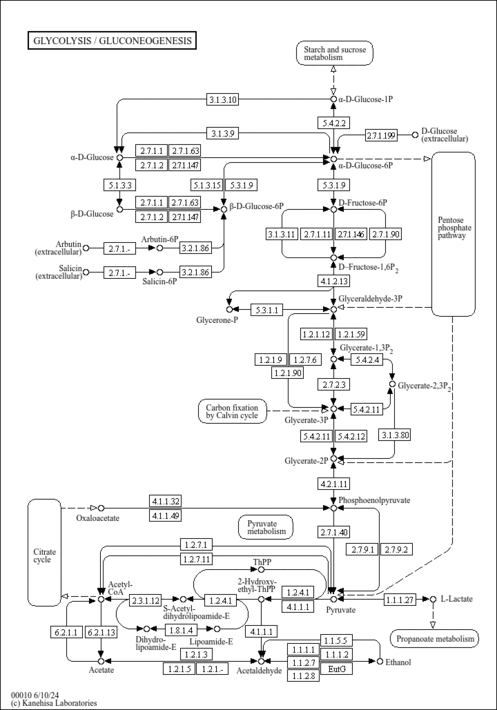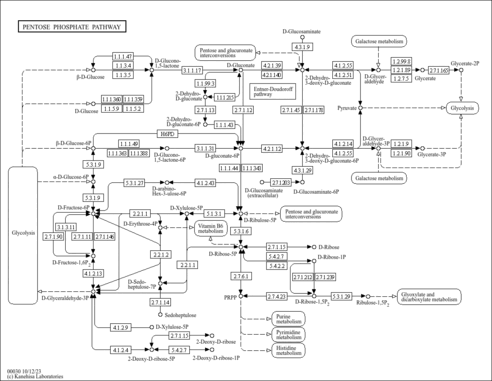| Record Information |
|---|
| Version | 1.0 |
|---|
| Created at | 2020-04-17 18:54:45 UTC |
|---|
| Updated at | 2020-11-18 16:39:06 UTC |
|---|
| CannabisDB ID | CDB004960 |
|---|
| Secondary Accession Numbers | Not Available |
|---|
| Cannabis Compound Identification |
|---|
| Common Name | beta-D-Glucose 6-phosphate |
|---|
| Description | beta-D-Glucose 6-phosphate, also known as b-D-glucose 6-phosphoric acid or 6-O-phosphono-b-D-glucopyranose, belongs to the class of organic compounds known as hexose phosphates. These are carbohydrate derivatives containing a hexose substituted by one or more phosphate groups. beta-D-Glucose 6-phosphate is an extremely weak basic (essentially neutral) compound (based on its pKa). beta-D-Glucose 6-phosphate exists in all living species, ranging from bacteria to humans. Outside of the human body, beta-D-Glucose 6-phosphate has been detected, but not quantified in, several different foods, such as breadnut tree seeds, green beans, celery stalks, sesames, and common beets. This could make beta-D-glucose 6-phosphate a potential biomarker for the consumption of these foods. A D-glucopyranose 6-phosphate in which the anomeric centre has beta-configuration. beta-D-Glucose 6-phosphate is expected to be in Cannabis as all living plants are known to produce and metabolize it. |
|---|
| Structure | |
|---|
| Synonyms | | Value | Source |
|---|
| 6-H2PO3glcbeta | ChEBI | | 6-O-Phosphono-beta-D-glucopyranose | ChEBI | | beta-D-Glucose 6-(dihydrogen phosphate) | ChEBI | | beta-D-Glucose 6-phosphic acid | ChEBI | | BETA-D-GLUCOSE-6-phosphATE | ChEBI | | 6-O-Phosphono-b-D-glucopyranose | Generator | | 6-O-Phosphono-β-D-glucopyranose | Generator | | b-D-Glucose 6-(dihydrogen phosphate) | Generator | | b-D-Glucose 6-(dihydrogen phosphoric acid) | Generator | | beta-D-Glucose 6-(dihydrogen phosphoric acid) | Generator | | Β-D-glucose 6-(dihydrogen phosphate) | Generator | | Β-D-glucose 6-(dihydrogen phosphoric acid) | Generator | | b-D-Glucose 6-phosphate | Generator | | b-D-Glucose 6-phosphoric acid | Generator | | beta-D-Glucose 6-phosphoric acid | Generator | | Β-D-glucose 6-phosphate | Generator | | Β-D-glucose 6-phosphoric acid | Generator | | b-D-GLUCOSE-6-phosphate | Generator | | b-D-GLUCOSE-6-phosphoric acid | Generator | | beta-D-GLUCOSE-6-phosphoric acid | Generator | | Β-D-glucose-6-phosphate | Generator | | Β-D-glucose-6-phosphoric acid | Generator |
|
|---|
| Chemical Formula | C6H13O9P |
|---|
| Average Molecular Weight | 260.14 |
|---|
| Monoisotopic Molecular Weight | 260.0297 |
|---|
| IUPAC Name | {[(2R,3S,4S,5R,6R)-3,4,5,6-tetrahydroxyoxan-2-yl]methoxy}phosphonic acid |
|---|
| Traditional Name | β-D-glucose 6-phosphate |
|---|
| CAS Registry Number | 15209-12-8 |
|---|
| SMILES | O[C@@H]1O[C@H](COP(O)(O)=O)[C@@H](O)[C@H](O)[C@H]1O |
|---|
| InChI Identifier | InChI=1S/C6H13O9P/c7-3-2(1-14-16(11,12)13)15-6(10)5(9)4(3)8/h2-10H,1H2,(H2,11,12,13)/t2-,3-,4+,5-,6-/m1/s1 |
|---|
| InChI Key | NBSCHQHZLSJFNQ-VFUOTHLCSA-N |
|---|
| Chemical Taxonomy |
|---|
| Description | Belongs to the class of organic compounds known as hexose phosphates. These are carbohydrate derivatives containing a hexose substituted by one or more phosphate groups. |
|---|
| Kingdom | Organic compounds |
|---|
| Super Class | Organic oxygen compounds |
|---|
| Class | Organooxygen compounds |
|---|
| Sub Class | Carbohydrates and carbohydrate conjugates |
|---|
| Direct Parent | Hexose phosphates |
|---|
| Alternative Parents | |
|---|
| Substituents | - Hexose phosphate
- Monosaccharide phosphate
- Monoalkyl phosphate
- Organic phosphoric acid derivative
- Alkyl phosphate
- Oxane
- Phosphoric acid ester
- Hemiacetal
- Secondary alcohol
- Oxacycle
- Organoheterocyclic compound
- Polyol
- Hydrocarbon derivative
- Alcohol
- Organic oxide
- Aliphatic heteromonocyclic compound
|
|---|
| Molecular Framework | Aliphatic heteromonocyclic compounds |
|---|
| External Descriptors | |
|---|
| Ontology |
|---|
|
| Disposition | Route of exposure: Source: |
|---|
| Role | Industrial application: |
|---|
| Physical Properties |
|---|
| State | Solid |
|---|
| Experimental Properties | | Property | Value | Reference |
|---|
| Melting Point | Not Available | Not Available | | Boiling Point | Not Available | Not Available | | Water Solubility | Not Available | Not Available | | logP | -3.643 | Not Available |
|
|---|
| Predicted Properties | [] |
|---|
| Spectra |
|---|
| EI-MS/GC-MS | | Type | Description | Splash Key | View |
|---|
| Predicted GC-MS | beta-D-Glucose 6-phosphate, non-derivatized, Predicted GC-MS Spectrum - 70eV, Positive | splash10-0005-9740000000-a6e81224fb97751dc2e6 | Spectrum | | Predicted GC-MS | beta-D-Glucose 6-phosphate, 4 TMS, Predicted GC-MS Spectrum - 70eV, Positive | splash10-001i-5572890000-1bd34b89c6cb6aadc13c | Spectrum | | Predicted GC-MS | beta-D-Glucose 6-phosphate, non-derivatized, Predicted GC-MS Spectrum - 70eV, Positive | Not Available | Spectrum | | Predicted GC-MS | beta-D-Glucose 6-phosphate, non-derivatized, Predicted GC-MS Spectrum - 70eV, Positive | Not Available | Spectrum |
|
|---|
| MS/MS | | Type | Description | Splash Key | View |
|---|
| Predicted MS/MS | Predicted LC-MS/MS Spectrum - 10V, Positive | splash10-03di-0490000000-1a5b3049c27a2a9b8996 | 2015-09-15 | View Spectrum | | Predicted MS/MS | Predicted LC-MS/MS Spectrum - 20V, Positive | splash10-03dm-4940000000-cbc695bef22278b36879 | 2015-09-15 | View Spectrum | | Predicted MS/MS | Predicted LC-MS/MS Spectrum - 40V, Positive | splash10-0uka-8900000000-320e52be29673422365e | 2015-09-15 | View Spectrum | | Predicted MS/MS | Predicted LC-MS/MS Spectrum - 10V, Negative | splash10-0a6r-6290000000-e76ad7d6142e19f5a9c2 | 2015-09-15 | View Spectrum | | Predicted MS/MS | Predicted LC-MS/MS Spectrum - 20V, Negative | splash10-004i-9000000000-e27be76de6d71ada7083 | 2015-09-15 | View Spectrum | | Predicted MS/MS | Predicted LC-MS/MS Spectrum - 40V, Negative | splash10-004i-9000000000-9540d84c7e74555e7a01 | 2015-09-15 | View Spectrum | | Predicted MS/MS | Predicted LC-MS/MS Spectrum - 10V, Negative | splash10-0a6s-9060000000-b446300429049a22bea4 | 2021-09-22 | View Spectrum | | Predicted MS/MS | Predicted LC-MS/MS Spectrum - 20V, Negative | splash10-004i-9000000000-d5aaca13a836cb9f1725 | 2021-09-22 | View Spectrum | | Predicted MS/MS | Predicted LC-MS/MS Spectrum - 40V, Negative | splash10-004i-9000000000-a5e502a2627af2048a1f | 2021-09-22 | View Spectrum | | Predicted MS/MS | Predicted LC-MS/MS Spectrum - 10V, Positive | splash10-03dm-0970000000-40dbaf3d3c72cf65bf47 | 2021-09-23 | View Spectrum | | Predicted MS/MS | Predicted LC-MS/MS Spectrum - 20V, Positive | splash10-01ot-7900000000-00bc03290b6c0bfb7f84 | 2021-09-23 | View Spectrum | | Predicted MS/MS | Predicted LC-MS/MS Spectrum - 40V, Positive | splash10-000t-9000000000-7a6ff6606f1dbc2f0ae4 | 2021-09-23 | View Spectrum |
|
|---|
| NMR | Not Available |
|---|
| Pathways |
|---|
| Pathways | | Name | SMPDB/Pathwhiz | KEGG | | Glycolysis |    |  | | Gluconeogenesis |    |  | | Pentose Phosphate Pathway |    |  | | Trehalose Degradation |    | Not Available | | Glucose-6-phosphate dehydrogenase deficiency |    | Not Available |
|
|---|
| Protein Targets |
|---|
| Enzymes | |
|---|
| Transporters | Not Available |
|---|
| Metal Bindings | |
|---|
| Receptors | Not Available |
|---|
| Transcriptional Factors | Not Available |
|---|
| Concentrations Data |
|---|
| Not Available |
|---|
| External Links |
|---|
| HMDB ID | HMDB0003498 |
|---|
| DrugBank ID | DB04122 |
|---|
| Phenol Explorer Compound ID | Not Available |
|---|
| FoodDB ID | FDB031291 |
|---|
| KNApSAcK ID | Not Available |
|---|
| Chemspider ID | 388538 |
|---|
| KEGG Compound ID | C01172 |
|---|
| BioCyc ID | GLC-6-P |
|---|
| BiGG ID | Not Available |
|---|
| Wikipedia Link | Not Available |
|---|
| METLIN ID | Not Available |
|---|
| PubChem Compound | 439427 |
|---|
| PDB ID | Not Available |
|---|
| ChEBI ID | 17719 |
|---|
| References |
|---|
| General References | Not Available |
|---|

